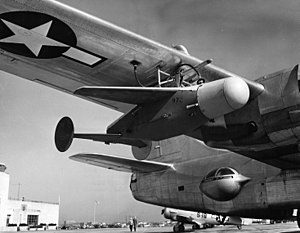Bat (guided bomb)
| ASM-N-2 Bat | |
|---|---|

Bat guided bomb mated to PB4Y Privateer
|
|
| Type | Conventional |
| Place of origin | United States |
| Service history | |
| In service | 1942 (Bomb MK 57) - 1953 (ASM-N-2) |
| Used by | United States Navy |
| Wars | World War II |
| Production history | |
| Manufacturer | National Bureau of Standards |
| Number built | 2580 |
| Specifications | |
| Weight | Airframe and guidance package only - 600 pounds (270 kg) |
| Length | 11 feet 11 inches (3.63 m) |
| Width | 10 feet (3.0 m) |
|
|
|
| Filling weight | 1,000 lb bomb (1,600 lb (727 kg) gross) |
The ASM-N-2 Bat was a United States Navy World War II radar-guided glide bomb which was used in combat beginning in April 1944.
In January 1941 RCA proposed a new TV-guided anti-shipping weapon called Dragon for which an operator would use the TV image sent from the nose of the weapon and operate aerodynamic controls during the weapon's fall. The National Bureau of Standards (NBS) would provide the airframe for use with a standard bomb, and was the same guidable ordnance airframe design used for the earlier, abortive Project Pigeon weapons program. The Pelican was a June 1942 modification to instead drop depth charges against submarines using semi-active radar homing. By mid-1943, the design was changed again to use a new active radar homing system from Western Electric with a 2,000-pound (907 kg) one short ton general-purpose (GP) bomb, the same basic "AN-M66" ordnance unit as used for the heavier USAAF VB-2 version of the Azon radio-controlled ordnance. This Pelican version entered testing in summer 1944 at Naval Air Station New York, where it hit its target ship in two out of four drops.
The Bat was the production version which combined the original NBS airframe with a 1,000-pound (454 kg) AN-M65 GP bomb, the same basic ordnance that was used in the contemporary Azon guided munition, and the Pelican active radar system. Gyrostabilized with an autopilot supplied by Bendix Aviation, the steerable tail elevator was powered by small wind-driven generators. The Navy's Bureau of Ordnance in partnership with the Massachusetts Institute of Technology (MIT) supervised development and the NBS was in charge of the overall development. Flight tests were conducted at the Naval Air Ordnance Test Station at Chincoteague Island, Virginia. Hugh Latimer Dryden won the President's Certificate of Merit for the development of the Bat, which "was flight tested by a small unit based at Philadelphia against targets in New Jersey."
...
Wikipedia
